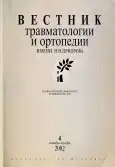Peculiarities of treatment of open fractures of long bones in patients with polytrauma
- Authors: Bialik E.I.1, Sokolov V.A.1, Semenov M.N.1, Evdokimova N.V.1
-
Affiliations:
- Moscow Institute of Emergency Medicine. N.V. Sklifosovsky
- Issue: Vol 9, No 4 (2002)
- Pages: 3-8
- Section: Articles
- URL: https://journals.rcsi.science/0869-8678/article/view/99978
- DOI: https://doi.org/10.17816/vto99978
- ID: 99978
Cite item
Full Text
Abstract
Basing on the experience in treatment of 244 patients with concomitant injuries including 305 patients with open long bone fractures the authors suggest the tactics for the management of these patients. That tactics depends on the general condition of injured, pattern of brain and internal organs, as well as on the presence of complications. Open fractures in polytrauma are characterized by prevalence of fractures of the 2nd—3rd degree by AO classification, high probability of purulent complications in fracture zones due to immunity decrease, the possibility of development of Clostridium infection. The authors conclude that the majority of patients with polytrauma require 2 steps treatment of open fractures. At the first stage primary surgical immobilization for the elimination of large displacement is performed. At the second stage immediately after wound healing osteosynthesis using blocking nails with or without reaming as well as AO plates was performed. That management tactics enabled to avoid the aggravation of patient’s condition at the early stage of treatment and to achieve fracture consolidation in 193 patients. Purulent complications were observed in 20.6%) of all injureds. Chronic osteomyelitis was noted only in 3.6% of patients at follow up.
Keywords
Full Text
##article.viewOnOriginalSite##About the authors
E. I. Bialik
Moscow Institute of Emergency Medicine. N.V. Sklifosovsky
Author for correspondence.
Email: info@eco-vector.com
Russian Federation
V. A. Sokolov
Moscow Institute of Emergency Medicine. N.V. Sklifosovsky
Email: info@eco-vector.com
Russian Federation
M. N. Semenov
Moscow Institute of Emergency Medicine. N.V. Sklifosovsky
Email: info@eco-vector.com
Russian Federation
N. V. Evdokimova
Moscow Institute of Emergency Medicine. N.V. Sklifosovsky
Email: info@eco-vector.com
Russian Federation
References
Supplementary files








